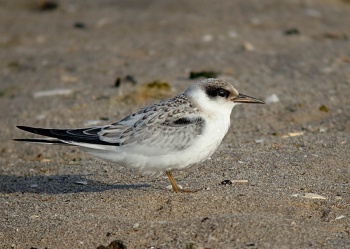- Sternula antillarum
Sterna antillarum
Identification
L. 22-24cm
- Pale grey upperparts
- White underparts
- White lower head
- Black cap down to the level of the eyes
- White front of head that intersects black back to above eyes
- Yellow bill that becomes black outside of breeding season
- Yellow legs
- Grey wings with black markings on outermost primaries
Similar Species
it is very noticeably smaller than other North American beach terns.
Distribution
Breeds in coastal and inland North America north to California and Maine, in Central America, the Caribbean and northern South America (mainly islands off Venezuela).
Northern birds migrate, and the species is found to Brazil in winter.
Taxonomy
Least Tern is closely related to, and was formerly often considered conspecific with, the Little Tern S. albifrons of the Old World. Other close relatives include Yellow-billed Tern S. superciliaris and Peruvian Tern S. lorata, both from South America. In the past, all were usually included in the genus Sterna.
Subspecies
There are 3 subspecies[1]:
- S. a. browni:
- Southern California to Baja and western Mexico; winters to Central America
- S. a. athalassos:
- S. a. antillarum:
Habitat
Breeds and winters in coastal areas, and to some extent uses inland waters such as rivers. Migrates along coasts but also more pelagic.
Behaviour
Diet
Mostly feeds on fish caught with plunge-dives, but can also take insects in the air.
Breeding
Normally nests colonially. Very aggressive in breeding season.
References
- Clements, JF. 2010. The Clements Checklist of Birds of the World. 6th ed., with updates to December 2010. Ithaca: Cornell Univ. Press. ISBN 978-0801445019. Spreadsheet available at http://www.birds.cornell.edu/clementschecklist/Clements%206.5.xls/view
Recommended Citation
- BirdForum Opus contributors. (2025) Least Tern. In: BirdForum, the forum for wild birds and birding. Retrieved 30 April 2025 from https://www.birdforum.net/opus/Least_Tern
External Links
GSearch checked for 2020 platform.1






